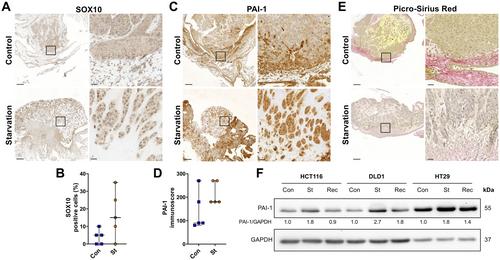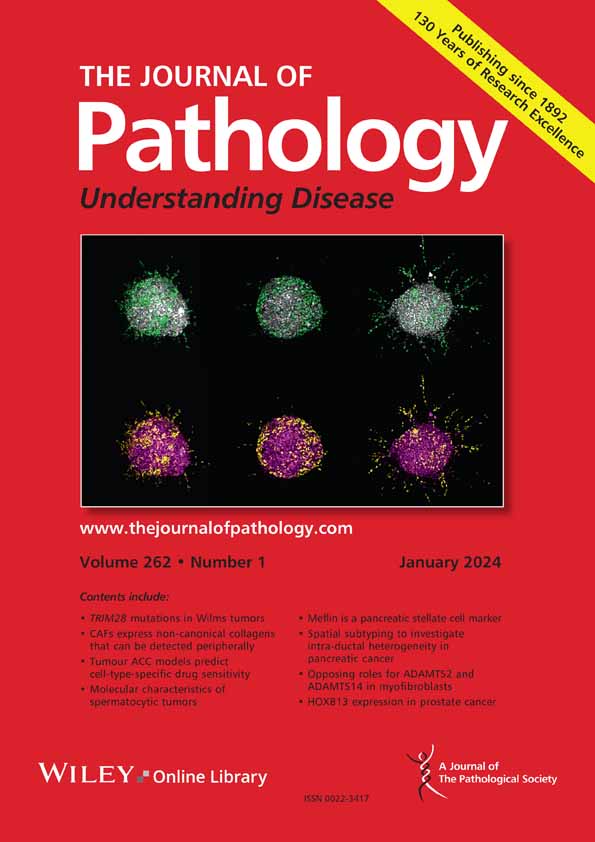A partial epithelial-mesenchymal transition signature for highly aggressive colorectal cancer cells that survive under nutrient restriction
IF 5.6
2区 医学
Q1 ONCOLOGY
Gil A Pastorino, Ilir Sheraj, Kerstin Huebner, Giulio Ferrero, Philipp Kunze, Arndt Hartmann, Chuanpit Hampel, Hepsen Hazal Husnugil, Arnatchai Maiuthed, Florian Gebhart, Fynn Schlattmann, Aliye Ezgi Gulec Taskiran, Goksu Oral, Ralph Palmisano, Barbara Pardini, Alessio Naccarati, Katharina Erlenbach-Wuensch, Sreeparna Banerjee, Regine Schneider-Stock
下载PDF
{"title":"A partial epithelial-mesenchymal transition signature for highly aggressive colorectal cancer cells that survive under nutrient restriction","authors":"Gil A Pastorino, Ilir Sheraj, Kerstin Huebner, Giulio Ferrero, Philipp Kunze, Arndt Hartmann, Chuanpit Hampel, Hepsen Hazal Husnugil, Arnatchai Maiuthed, Florian Gebhart, Fynn Schlattmann, Aliye Ezgi Gulec Taskiran, Goksu Oral, Ralph Palmisano, Barbara Pardini, Alessio Naccarati, Katharina Erlenbach-Wuensch, Sreeparna Banerjee, Regine Schneider-Stock","doi":"10.1002/path.6240","DOIUrl":null,"url":null,"abstract":"<p>Partial epithelial-mesenchymal transition (p-EMT) has recently been identified as a hybrid state consisting of cells with both epithelial and mesenchymal characteristics and is associated with the migration, metastasis, and chemoresistance of cancer cells. Here, we describe the induction of p-EMT in starved colorectal cancer (CRC) cells and identify a p-EMT gene signature that can predict prognosis. Functional characterisation of starvation-induced p-EMT in HCT116, DLD1, and HT29 cells showed changes in proliferation, morphology, and drug sensitivity, supported by <i>in vivo</i> studies using the chorioallantoic membrane model. An EMT-specific quantitative polymerase chain reaction (qPCR) array was used to screen for deregulated genes, leading to the establishment of an <i>in silico</i> gene signature that was correlated with poor disease-free survival in CRC patients along with the CRC consensus molecular subtype CMS4. Among the significantly deregulated p-EMT genes, a triple-gene signature consisting of <i>SERPINE1</i>, <i>SOX10</i>, and epidermal growth factor receptor (<i>EGFR</i>) was identified. Starvation-induced p-EMT was characterised by increased migratory potential and chemoresistance, as well as E-cadherin processing and internalisation. Both gene signature and E-cadherin alterations could be reversed by the proteasomal inhibitor MG132. Spatially resolving EGFR expression with high-resolution immunofluorescence imaging identified a proliferation stop in starved CRC cells caused by EGFR internalisation. In conclusion, we have gained insight into a previously undiscovered EMT mechanism that may become relevant when tumour cells are under nutrient stress, as seen in early stages of metastasis. Targeting this process of tumour cell dissemination might help to prevent EMT and overcome drug resistance. © 2024 The Authors. <i>The Journal of Pathology</i> published by John Wiley & Sons Ltd on behalf of The Pathological Society of Great Britain and Ireland.</p>","PeriodicalId":232,"journal":{"name":"The Journal of Pathology","volume":"262 3","pages":"347-361"},"PeriodicalIF":5.6000,"publicationDate":"2024-01-18","publicationTypes":"Journal Article","fieldsOfStudy":null,"isOpenAccess":false,"openAccessPdf":"https://onlinelibrary.wiley.com/doi/epdf/10.1002/path.6240","citationCount":"0","resultStr":null,"platform":"Semanticscholar","paperid":null,"PeriodicalName":"The Journal of Pathology","FirstCategoryId":"3","ListUrlMain":"https://onlinelibrary.wiley.com/doi/10.1002/path.6240","RegionNum":2,"RegionCategory":"医学","ArticlePicture":[],"TitleCN":null,"AbstractTextCN":null,"PMCID":null,"EPubDate":"","PubModel":"","JCR":"Q1","JCRName":"ONCOLOGY","Score":null,"Total":0}
引用次数: 0
引用
批量引用
Abstract
Partial epithelial-mesenchymal transition (p-EMT) has recently been identified as a hybrid state consisting of cells with both epithelial and mesenchymal characteristics and is associated with the migration, metastasis, and chemoresistance of cancer cells. Here, we describe the induction of p-EMT in starved colorectal cancer (CRC) cells and identify a p-EMT gene signature that can predict prognosis. Functional characterisation of starvation-induced p-EMT in HCT116, DLD1, and HT29 cells showed changes in proliferation, morphology, and drug sensitivity, supported by in vivo studies using the chorioallantoic membrane model. An EMT-specific quantitative polymerase chain reaction (qPCR) array was used to screen for deregulated genes, leading to the establishment of an in silico gene signature that was correlated with poor disease-free survival in CRC patients along with the CRC consensus molecular subtype CMS4. Among the significantly deregulated p-EMT genes, a triple-gene signature consisting of SERPINE1 , SOX10 , and epidermal growth factor receptor (EGFR ) was identified. Starvation-induced p-EMT was characterised by increased migratory potential and chemoresistance, as well as E-cadherin processing and internalisation. Both gene signature and E-cadherin alterations could be reversed by the proteasomal inhibitor MG132. Spatially resolving EGFR expression with high-resolution immunofluorescence imaging identified a proliferation stop in starved CRC cells caused by EGFR internalisation. In conclusion, we have gained insight into a previously undiscovered EMT mechanism that may become relevant when tumour cells are under nutrient stress, as seen in early stages of metastasis. Targeting this process of tumour cell dissemination might help to prevent EMT and overcome drug resistance. © 2024 The Authors. The Journal of Pathology published by John Wiley & Sons Ltd on behalf of The Pathological Society of Great Britain and Ireland.
在营养限制条件下存活的高侵袭性结直肠癌细胞的部分上皮-间充质转化特征。
部分上皮-间质转化(p-EMT)最近被确定为一种混合状态,由同时具有上皮和间质特征的细胞组成,与癌细胞的迁移、转移和耐药性有关。在这里,我们描述了饥饿状态下结直肠癌(CRC)细胞中 p-EMT 的诱导,并确定了可预测预后的 p-EMT 基因特征。饥饿诱导的 p-EMT 在 HCT116、DLD1 和 HT29 细胞中的功能表征显示了增殖、形态和药物敏感性的变化,并得到了使用绒毛膜模型进行的体内研究的支持。研究人员利用 EMT 特异性定量聚合酶链反应(qPCR)阵列来筛选失调基因,从而建立了与 CRC 患者无病生存率低和 CRC 共识分子亚型 CMS4 相关的硅学基因特征。在明显失调的 p-EMT 基因中,发现了由 SERPINE1、SOX10 和表皮生长因子受体(EGFR)组成的三重基因特征。饥饿诱导的 p-EMT 的特征是迁移潜力和化疗抗性增加,以及 E-cadherin 处理和内化。蛋白酶体抑制剂MG132可逆转基因特征和E-粘连蛋白的改变。利用高分辨率免疫荧光成像对表皮生长因子受体表达进行空间分辨,发现了表皮生长因子受体内化导致的饥饿 CRC 细胞增殖停止。总之,我们已经深入了解了一种以前未被发现的 EMT 机制,当肿瘤细胞处于营养压力下时,这种机制可能会变得相关,就像在转移的早期阶段所看到的那样。针对肿瘤细胞扩散的这一过程可能有助于防止 EMT 和克服耐药性。© 2024 作者。病理学杂志》由约翰威利父子有限公司代表大不列颠及爱尔兰病理学会出版。
本文章由计算机程序翻译,如有差异,请以英文原文为准。
来源期刊
期刊介绍:
The Journal of Pathology aims to serve as a translational bridge between basic biomedical science and clinical medicine with particular emphasis on, but not restricted to, tissue based studies. The main interests of the Journal lie in publishing studies that further our understanding the pathophysiological and pathogenetic mechanisms of human disease.
The Journal of Pathology welcomes investigative studies on human tissues, in vitro and in vivo experimental studies, and investigations based on animal models with a clear relevance to human disease, including transgenic systems.
As well as original research papers, the Journal seeks to provide rapid publication in a variety of other formats, including editorials, review articles, commentaries and perspectives and other features, both contributed and solicited.


 求助内容:
求助内容: 应助结果提醒方式:
应助结果提醒方式:


